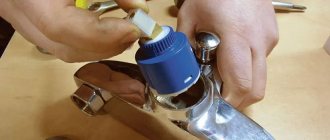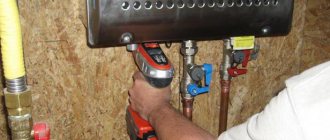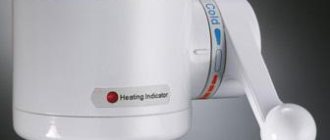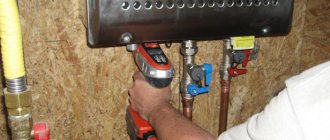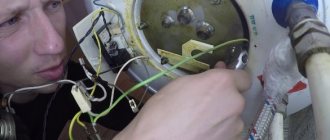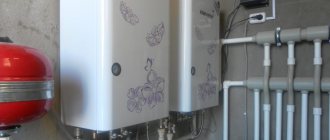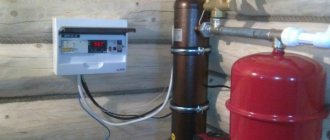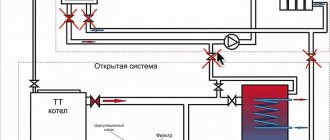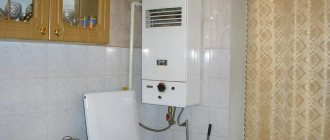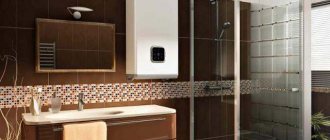How does an electric water heater for heating work?
As a rule, such devices are used exclusively for hot water supply. But modern technologies make it possible to use it as an additional thermal circuit for heating water in a heating system. Before using the water heater to prepare the coolant for heating devices, it is necessary to modernize its recharge circuit:
Create a forced coolant circulation circuit.
It is necessary to connect the heating circuit with the installation of protection and control devices: an expansion tank, a circulation pump and shut-off and control valves, a control and protection unit with primary sensors for temperature and pressure of the medium.
The originality of the idea, and its practical implementation, lies in the synchronous operation of the same source: for hot water supply and heating. For this reason, it is recommended to first select an electric pump of the required electrical power. It must be able to cover all hydraulic losses in the system and evenly distribute heat throughout the heating devices. Experts recommend installing water purification filters at the inlet in front of the boiler in simultaneous hot water and heating systems.
Storage tank and heating boiler
The storage tank is ultimately completely identical to a classic water heater. The difference lies in the internal coil, which is connected to the heating system.
A professionally organized heat supply system through a heat exchanger implies that this component will act as a thermal accumulator. The liquid medium in the tank receives heat through a coil heat exchanger connected to the in-house heating pipe system.
Indirect heating boiler
The optimal alternative for heating small rooms is to include an indirect heating boiler in the heat supply scheme. They can be universal, capable of operating on different types of energy carriers: gas, flue gases from the combustion of solid fuels and electricity.
Typically, such devices are installed in heat supply circuits to increase overall efficiency in the form of an additional heating source. The main one is the traditional heating boiler. For efficient operation of an indirect heating water heater, it must be installed before entering return network water into the boiler unit. In this way it is possible to create an optimal heating system.
Operating principle of a water heater for heating
Operating principle of a heating water heater
Typically, a boiler is used only for hot water supply. Structurally, it is a container inside which heating elements are located. When filled, they heat the liquid to the required level. Then, through the outlet pipe, it flows into plumbing fixtures - faucets in the kitchen and bathroom. But in addition to this, you can make an additional circuit for heating the air in the rooms.
Before using the water heater for heating, the following conditions must be met:
- Ensure fluid circulation in the pipes. If you constantly fill the container with running water, the heating rate of the coolant will be minimal. Make a closed circuit with circulation;
- Installation of the necessary heating elements - expansion tank, pump and shut-off valves;
- Provide for the possibility of replenishing coolant from the water supply system.
But how can a water heater be used for heating if it is not structurally designed for this? The specificity of the design and practical implementation of this task lies in the simultaneous use of the same water for hot water heating of the room. Therefore, first of all, it is necessary to install a pump of a certain power, which would ensure uniform heating by the water heater through the constant movement of liquid in the pipes. Then you should make a filtration system. The water must be purified before entering the circuit, since flow water is characterized by a large number of impurities that negatively affect the condition of pipes and heating devices.
Before purchasing an electric water heater, you need to find out whether it is suitable for heating. First of all, this concerns the availability of convenient controls with the ability to quickly regulate the temperature level in the tank.
Is it worth installing water heaters from the heating system if there are electric boilers specially designed for this? Let's look at the characteristics of both systems.
How to save energy using a boiler?
The question itself is basically absurd. We purchase a boiler, first of all, to make our home more comfortable. It is often used where it is not possible to obtain hot water for washing dishes and household needs. The same daily shower requires a considerable amount of both cold and hot water. A boiler is an electric device and therefore requires a certain consumption of electricity to heat water. Therefore, we just have to learn how to save electricity by heating water using a boiler.
Everyone knows that a boiler is a device for continuously maintaining water of a certain volume at a given temperature. Therefore, most often the boiler always remains on and switches off from the mains periodically and automatically. However, some thrifty people at print-craft.ru go further and turn it off themselves so as not to waste electricity.
Distinctive features of the boiler for the heating system
As you know, a boiler is a closed vessel that has two holes.
The first hole serves as an inlet for cold water, the second as an outlet for hot water. The boiler is powered from the electrical network. All boilers are divided into two groups - flow-through and storage. In a storage boiler, a certain amount of water is heated (the amount of water depends on the displacement of the boiler); in a flow-through boiler, any amount of water can be heated, but this requires more electricity. It must be said that using a boiler for heating is quite possible; moreover, today manufacturers produce boilers specifically designed for heating water in the system. These boilers have two significant differences from those intended exclusively for heating water for domestic purposes - for example, for bathing or washing dishes.
Firstly, in such boilers the inlet for cold water is located at the bottom, and the outlet for hot water is at the top. This arrangement of the holes is explained by the fact that when the water heats up, it rises, and therefore the hottest water is located at the top of the boiler, and it is the use of such water that will make the heating system as efficient as possible.
Secondly, the boiler, designed for heating water in the heating system, has a large hole diameter. If you look at factory-made boilers, you will see that both the cold water inlet and the hot water outlet are never smaller than 2 inches in diameter (about 4.8 cm).
If the boiler has both of these distinctive features, then it can safely be used as the basis for a heating system - that is exactly what it is intended for. And the movement of water through the heating system itself is carried out due to the fact that cold and hot water have different densities, and cold water, entering the boiler, displaces the hot water first to the top, and then through the hole into the pipes of the system.
Instructions for starting the boiler for the first time
Boiler installed
Whether the installation work was carried out by specialists or the owner does not matter. In any case, you need to check the operation of the system
To do this, following the given tips, you need to start the heater for the first time.
We start by checking the correct connection of the systems that are responsible for heating the water. Fidelity, reliability of connection of phase and neutral wires, presence of grounding. The functionality of the circuit breaker should also be checked. To do this, use a device - a tester or a special electrician's screwdriver.
Next comes the search for leaks in the system. It would be useful to control the connection of underwater pipes. Presence and diagnostics of check valve operation.
Running water into the boiler
Attention, the correct sequence of actions for the first and subsequent starts of the system will be described in the next section. Repeated search for water leaks in pipe installation areas.
Diagnostics of heater operation. Turn on the device by pressing the power button.
Fixing the initial temperature sensor readings.
Recheck after 15 minutes
An increase in indicators indicates the correct connection of the heating elements.
Water heater maintenance
The list of maintenance work is not too lengthy:
- replacing the magnesium anode;
- descaling;
- checking the inlet check valve.
It should be noted that many boiler service technicians, in private conversations or in discussions on thematic forums, give the following advice: as long as the water heater is working normally, there is no need to disassemble it or change anything. There are cases where boilers worked properly for 10 years or more without any intervention - it all depends on the amount of salts in the water, that is, its hardness.
If the boiler is expensive and under warranty, it is better to change the anode with the help of service specialists
If the device has clearly become worse at heating water, and when the heater is operating, a hissing or crackling sound is heard inside, it means that the scale layer has developed a significant thickness and it is really time to change the magnesium anode
At the same time, the tank and heating element must be carefully cleaned of salt deposits
Those whose tap water has increased hardness are advised to take measures to soften it. There are two ways:
- Install a softening filter with a cartridge filled with ion exchange resin in front of the boiler. This substance replaces calcium and magnesium ions with harmless sodium. It is better to choose filters that can be regenerated (restored) at home.
- Installation of a hydromagnetic system (HMS). This device is non-volatile. It is equipped with a permanent magnet, the field of which causes crystallization of hardness salts, as a result of which they turn from solution into sludge - a suspension of small particles. The sludge is retained by a fine filter installed after the magnet.
Instructions for starting a Thermex boiler
If installation of equipment is usually carried out by specialists, then the owners themselves have to deal with its startup at least once a year. Let's take a closer look at how to turn on a Termex water heater so as not to negatively affect its performance properties. After all, the duration of operation and frequency of maintenance largely depend on the correct execution of the process.
Work order
Turning on the boiler: The steps for starting the water heater and the settings may vary slightly. It all depends on whether a flow or storage device is used. However, despite the design differences, the order of their inclusion has the same principle. The universal instructions for starting a Termex boiler are as follows:
- Before turning on the water heater, the shut-off valve for supplying hot liquid from the common riser is closed.
This occurs even if a check valve is installed on the pipe. After all, if there is a slight malfunction, the device will heat the central water supply without blocking the channel. - Before connecting the Termex storage water heater to the network, it is filled with water. The outlet of the hot liquid device and the mixer open in turn, and after them the inlet of the cold flow. These manipulations are necessary to displace air from the system.
- After the water has flowed in an even stream, you can turn it off, turn on the unit to the power grid and, after setting the settings and waiting an hour or two, start using it.
The connection diagram for a Thermex water heater when using flow-type devices will be similar, except that the result will be felt immediately.
The next stage after switching on is checking the functionality. Before using the Thermex water heater you need to:
- Make sure that the power indicators light up when plugged in.
- Measure the temperature of the liquid supplied to the mixer.
- After 20 minutes, look at the equipment sensors; if the connection of the boiler with the touch panel is done correctly, the temperature indicator on the device should already increase. If there is no electronic panel, you must once again measure the degree of heating of the water at the outlet of the mixer.
What to do if Thermex does not turn on
The installation process of a Thermex instantaneous water heater or any other model requires the presence of serviceable network elements: sockets, circuit breakers, cables of sufficient thickness. The devices have very high power, so if they do not work, first of all, armed with a tester, you need to check the presence of electricity in the outlet, then the power terminals. Video instructions for installing a Termex water heater will help you find their location, and the tester will help you take readings. If the voltage is zero, then the cable of the electrical appliance is broken.
What to do if the Thermex water heater does not turn on, or rather, power is supplied, but it gives an error - the most popular question. In this case, you need to open the device instructions and look at the explanation corresponding to the code indicated on the display. If this option is not available, the causes of the problem may be the following:
The heating element has a damaged or burnt-out coil. A sign is often a breakdown of electricity on the housing, then the RCD automatically trips and cuts off the power supply. The only way to combat this is by replacing the heating element. The protection is triggered if the heating of the coolant rises above the set limit (usually more than 90 degrees), which occurs both when the control thermostat breaks down and when scale accumulates on the heating element, after which it overheats. The tank is not filled with water. How to turn on a Thermex ID 50V boiler or another model for the first time was discussed above, and if the requirements for removing air from the pipes are not met, a protective mechanism is triggered
Please note that this must be done even if the system is full but has not been used for a long time.
Features of the electric boiler
The main design elements of an electric heating boiler are a tank and a heating element. The devices are equipped with monitoring and automatic control systems.
Various models may also include expansion tanks and circulation pumps.
When purchasing a boiler, you should pay attention to the type of electric heating element. Over time, lime particles settle on the heating elements, which affects the power of the device
Electric boilers have several advantages:
- Fire safety . Thanks to automatic control systems and the absence of open flames, the devices are safe. They do not emit toxic substances or combustion products and are not capable of exploding.
- Ease of installation. Electrical equipment requires no flue or ventilation, making installation easy.
- High efficiency . Regardless of the type of heating device, all electric boilers are highly efficient.
- Compactness . Electrical appliances, especially wall-mounted ones, take up little space.
- Nice design . Most modern models are stylistically versatile and look good in the interior.
Electric boilers are almost ideal - easy to use and safe. Their only serious drawback is the high cost of electricity. One more nuance: for residents of regions where there are frequent interruptions in the power grid, it is better to choose boilers that operate from other energy sources, or take care of purchasing additional heating devices.
How to use the boiler?
Turn on the unit and set the desired hot water temperature. On most heaters, manufacturers provide 3 positions: 35, 55-57 and 75 ºС. Some models also have a fourth position – “anti-freeze”, then the temperature in the tank is maintained at 10 ºС. The actual operation is to set the temperature regulator to the desired position and use water. In this case, it is worth following these recommendations:
- never turn on the boiler if for some reason the unit’s tank is empty, this can lead to failure of the heating element. The inlet safety valve has a built-in check valve; its performance must be checked at least once a year;
- Although the boiler temperature is adjusted according to your wishes, you need to turn it on to maximum once every 2 weeks and maintain this mode for 2 hours. This is necessary so that harmful bacteria living in warm water do not multiply in the tank;
- There should be a strainer at the cold water inlet into the house. If the water is hard, then it is necessary to organize additional cleaning and desalting, otherwise all heating equipment, including the boiler, will not last long;
- Once every 2 years, clean the tank from scale, and also check the condition of the protective magnesium anode and, if necessary, change it.
Using an electric instantaneous water heater is also quite simple. The device turns on immediately after opening the tap, the water temperature is regulated by decreasing and increasing the pressure. When the water runs too hot, the pressure must be increased; if it is cold, then decrease. For these devices, water hardness is also important; the presence of a large amount of salts will cause scale inside the heating element. First, the heating intensity will drop, and then the element will fail.
Installation and operation of a heating boiler
Boiler in the heating system
After completing all the necessary calculations of the boiler power and its volume, you can begin to integrate the device into the heating system
An important task is to determine the installation location. Having decided on the purpose of the boiler in the heating system, you need to read the instructions for its installation
The best option would be installation in close proximity to the boiler. In this case, the transfer of thermal energy from the coolant to water is most effective.
But at the same time, you may encounter the following difficulties in organizing heating using a boiler:
- DHW system supply. In a heating system with a solid fuel boiler, it is most convenient to place the boiler directly in the boiler room. But then to supply heated water to the premises you will need a separate pump and control devices for it;
- Large capacity capacity. if heating through a boiler is planned for large residential areas. There is a problem with the placement of the heating element;
- Electrical supply to ensure the operation of the heating element. For the normal functioning of the boiler for heating a private house, it is also recommended to install an autonomous source of electricity.
Having resolved these issues, you can proceed directly to installation.
The heating water temperature through the boiler is controlled using an installed thermometer. It is not included in the standard package and therefore must be purchased separately.
Installation of a heating storage tank
To install the heat accumulator, it is necessary to prepare a flat area in advance. Its heavy weight should be taken into account - if necessary, a separate foundation is made or the floors are reinforced.
The optimal installation option is on a separate platform. This way you can avoid contact of the housing with the concrete surface, which will reduce heat losses in the electric heating boiler. Almost all manufacturers make containers with special legs. If they are missing, it is recommended to install insulation on the floor.
The procedure for connecting the boiler to the heating system is to perform the following steps:
After installing the container, you need to check its position relative to the horizon. No deviations are allowed. Connect to heating
It is important that the diameter of the pipes is equal. Otherwise, after connecting the boiler to the heating system, excess hydraulic resistance will appear. If installation is carried out in an unheated room, the boiler body is insulated. A connection to the hot water supply is made so that the boiler works not only for heating, but also for hot water supply.
Upon completion of this work, you need to check the tightness of all connections and start the heating system. It is recommended to measure the temperature of the water in the tank and the coolant in the pipes within 2-3 weeks after the boiler is turned off. This way you can determine the actual time of maintaining the required heating level in the heating circuit from the boiler.
In order to make full heating from a boiler, it is not recommended to use antifreeze. It is characterized by a relatively low heat capacity, which will affect the transfer of heat to water and back to the coolant.
Conditions for proper operation of the boiler
Scale on the heating element of the boiler
Servicing a storage tank is practically no different from carrying out the necessary procedures to maintain the functionality of any electric boiler with heating elements. And in this case, in order for the boiler to work normally in the heating system of a private home, you must follow the manufacturer’s recommendations.
This can be ensured even before the heat supply from the boiler is made. It is best to purchase models with the so-called “dry heating element”. On it, scale formation occurs much more slowly. You should also pre-filter the water before feeding it into the storage tank.
In addition to these procedures, you must do the following:
- Once a month, check the integrity of the thermal insulation of the structure;
- Monitor the duration of maintaining the coolant temperature during the heat supply mode through the boiler. The difference between calculated and actual indicators should not exceed 15%;
- Checking the tightness of connections. It is recommended to replace the gaskets before each heating season. This way you can achieve more reliable heating of a private home using a boiler.
The control unit of some models is sensitive to voltage changes. To avoid damage to this expensive device, you should connect a stabilizer for the boiler in the heating system.
To clean the heating element from scale, you must dismantle it. But before that, you need to find out from the seller whether the factory warranty is still valid.
Rules for using a water heater
Before using the boiler, you need to consider the following rules:
- Initially, the device needs to be installed. Proper installation will determine the service life of the device. When installing, you must comply with the manufacturer's requirements.
- Before turning on the heater, you must close the hot water riser. Then the boiler output is connected to it and the system is started. To disconnect, you need to perform the steps in the reverse order.
- When the homeowner leaves for an extended period of time, the heater is disconnected from the power supply.
- Maintenance of the device is required annually.
- The higher the water temperature is set, the more it can be diluted and the slower it will be consumed.
- When there are a large number of consumers in the house, the maximum temperature is set.
Boiler market overview
Today, there are many Russian and foreign manufacturers on the domestic water heater market, although the latter are predominantly dominant: MTS, Lorenzi Vasco and others.
Many manufacturers are opening full-cycle production in Russia, producing basic components. This allows us to reduce the price on the domestic market and increase the availability of products for a wide range of consumers. One of these developers is considered to be the Italian corporation Ariston, whose heaters have actually already become a domestic brand.
It has been successfully operating in the Russian market for a long period of time, opening its factories and providing Russians with high-quality heaters. The range of models includes various types of water heating equipment.
Ariston is one of the most recognizable brands of water heatersSource goods.ru
The prevalence of Ariston boilers among buyers is quite high due to the quality of the products and the regular introduction of innovative technologies.
Before using the Ariston water heater, let’s consider its technological and design features:
- the model range includes round and flat heaters of various sizes with a bright design;
- high-quality thermal insulation of boilers and automatic control of operating modes make it possible to save on electricity;
- heater tanks are made of special stainless steel with increased anti-corrosion resistance;
- different models use electronic and mechanical control, which makes it possible to control the water heating process;
- in instantaneous boilers, the heating module is made of copper, which increases its service life;
- In a number of boiler models, the internal coating of the tanks is covered with bioglass porcelain, which completely eliminates the occurrence of corrosion.
In addition, the product range includes electric heaters with a mixed water heating system.
Ariston water heater with touch controlSource santeh.ks.ua
Installation of a gas boiler with a boiler
- The instructions for installing a boiler say that when a boiler is used to heat a private house with indirect heating, the temperature in its heat exchanger increases from the boiler, the coolant is heated and enters the distribution of pipes and radiators (read: “How to install an indirect heating boiler - types of device and methods installation"). Thus, recirculation or, in other words, partial return of thermal energy occurs, since the liquid in the heat exchanger heats the coolant coming from the boiler. Then the water, having passed through the heating system, returns to the gas boiler with a built-in boiler.
- To ensure boiler heating of a private house for the purpose of normal coolant circulation in the system circuit, a circulation pump operating in automatic mode is used. Pumping is turned on when the water temperature drops to the level specified by the program. Typically, manufacturers install heating elements for additional heating.
- The boiler in the heating system is equipped with a gas heater or other boiler that runs on any fuel, which can be coal, wood, electricity, diesel fuel (read: “Heating boilers using diesel fuel - characteristics”). It is also allowed to use solar energy to heat the device, and then the amount of heated water can not be limited. In addition, the boiler heating system provides the ability to provide heating with two energy sources, although this will require another heat exchanger.
Method of heating water with a water heater
Modern electric water heaters for heating operate on the same principle as boilers. A large sealed container is filled with water, which is heated using electric heating elements. In this case, heat loss occurs through the housing.
In boilers, the coolant increases the temperature when passing through a heat exchanger with a built-in heating element. Since the volume of this chamber is relatively small, heating occurs quickly. At the same time, heat losses are minimal. It should also be noted that in most cases the design already includes a circulation pump, an expansion tank and a convenient control system. Apart from the latter, electric water heaters for heating of the VEO type do not have these elements.
Heating inertia
The rate of increase in water temperature in pipes for electric boilers is quite high. The average heating time from 25 degrees to 60 degrees is 15-20 minutes, depending on the volume of the system. In this regard, heating using a water heater is significantly inferior to traditional heating. In order for the volume of water in a boiler with a capacity of 150 liters to reach the desired temperature, you need to wait about an hour. The main criteria influencing this indicator are the power of heating elements, the volume of the tank and the entire system as a whole.
However, when the electric boiler stops working, the water in the pipes quickly cools down. At the same time, in a water heater system, a large volume of hot liquid is in the tank and will require several circulation cycles for it to cool. Those. In the event of an unexpected power outage, the coolant in the boiler system will remain hot for some time.
Summarizing these factors, we can determine the main conditions for using an electric water heater for heating:
- The area of the heated room should be relatively small. This is due to the ratio of 1 kW of thermal energy per 10 sq.m.;
- Good quality running water to preserve all heating elements;
- To fill the tank, it is necessary to create the same pressure as in the water supply - 4 atm. This applies only to those cases when a regular boiler is installed that is not intended for heating from a water heater. In specialized models, the minimum pressure value is much lower - from 1.5 atm.
You can use an electric water heater to heat a house with a small area of up to 80 square meters. First of all, this applies to country houses.
The second way to use an instantaneous water heater for heating is to install a heated floor system. But even in this case, you must carefully read the diagram for connecting the device to the pipeline.
Water heater or electric boiler?
Water heater connection diagram
The idea of using instantaneous water heaters for heating arose when the first electric boilers appeared on the market. But most often, electric boilers are installed, which are designed specifically for heating. The relevance of installing instantaneous water heaters from a heating system can be determined after a comparative analysis of these devices with boilers.
An important indicator is the efficiency of the system - the ratio of the thermal energy received to the energy expended. In this regard, electric boilers are much more efficient - their figure reaches 90%. At the same time, most instantaneous electric water heaters for heating have an efficiency of no more than 70%. This is due to the specifics of the designs and the method of increasing the temperature of the coolant. Next, you should take into account certain performance qualities.
The use of an instantaneous water heater is only possible for closed systems with forced circulation. This is explained by the specific operation of the device.
Pipe material for piping BKN
The thermohead regulator sets the desired water heating temperature no higher than the boiler supply temperature. Also in the passports are instructions for use.
The heating temperature and pressure on the pipes determine which material is preferable to use when piping: Cold water - a regular polypropylene pipe can be installed. The supply of coolant is regulated by a thermostat, which opens and closes depending on the temperature of the water in the tank. The BKN piping must solve several important problems: ensure continuous circulation of coolant from the boiler to the water heater; prevent hydraulic and thermal shock; maintain the set water heating temperature in automatic mode.
What is heating with priority Before installing an indirect heating boiler in the DHW system, you need to choose the principle of its connection: with or without priority. The thing is that the liquid constantly circulates around the ring and cools, so the boiler spends much more resources on constantly heating it.
In addition, the temperature reduction is enhanced by mixing different layers of liquid. If more intense heating is required, this can happen if the boiler usually operates in low temperature mode, then it is better to choose a model with a built-in heating element. The material is suitable for soldering the entire cold water supply system. If the client turns off the boiler, then make sure that when the boiler is turned off, all systems and equipment are turned off. Also look for an electrical diagram for connecting the boiler to the boiler. Connecting an indirect heating boiler for this case is shown in the diagram below. In addition to installing and connecting the BKN, regular maintenance will be required.
Subscribe to receive new articles. To do this, we can shut off the heating circuit and leave only the indirect heating boiler running. The current load, as a rule, is not less than 10 A. Such devices are connected to heating systems that use boilers that are not equipped with automation. To connect, you will have to make the heating system in two circuits, the first - to generate heat in the house, the second, which has a higher priority, - for the boiler, that is, if the water temperature in the unit drops, the three-way valve will switch the hot water to the heating circuit until the desired one returns temperature.
Nuances of the piping device It is easier to do the wiring and piping if the KN boiler is installed together with the boiler, pumps and other equipment involved in the assembly of the hot water supply system. Let's take the simplest case, when the water heater already has automation. From experience we can say that it is better not to use a dry heating element. The first scheme of a heating system with an indirect heating boiler directs the entire volume of coolant to warm up the tank, which ensures very fast heating of water.
That is, steel pipes become overgrown. In this case, the boiler heats up faster, but then the heating stops completely and with prolonged inactivity, the temperature in the batteries can drop significantly. If the heating appliances are turned off for minutes, the temperature in the rooms is unlikely to drop in such a short period of time, but there will be enough heated water. Connecting an indirect heating boiler with recirculation The second option is to use models that do not have an input for connecting the recirculation circuit, but connect it using tees. That is, during DHW preparation, the heating circuit is switched off. Boiler room equipment. What elements does a modern boiler house consist of?
Indirect heating boiler
This unit is a sealed tank with a built-in electric coil. The water in it is heated by circulating liquid in a closed circuit and coming into contact with the heating element. Electric operation allows you to constantly have a supply of warm water, and an intelligent control system ensures comfortable operation of the device. Such equipment is made of stainless steel with a heat-insulating glass-ceramic coating.
A sealed container with a volume of up to 1000 liters can provide hot water to a large mansion. Depending on the design and type, the indirect boiler is connected to the gas supply system or to the electrical network. Such equipment is equipped with an automated control mechanism. In winter, the unit can be used for heating and hot water supply, and in summer only for heating liquids.
Indirect water heater device.
Such devices are characterized by high performance, efficiency and good ergonomics. Indirect boilers are either wall-mounted or floor-mounted. The unit takes some time to initially heat the water. Subsequently, the set temperature is maintained automatically. Heat loss is minimal thanks to reliable thermal insulation. Similar heating equipment can be purchased in the Kvanta+ online store in Tyumen.
Boiler selection
In the case of a flow-through boiler, select the power and size of the device itself. It’s also worth adding a power source here, because they are rarely gas - mostly electric instantaneous water heaters are sold in stores.
If we are talking about savings, then everything depends on the method of use and the size of the family. Boilers up to 15 liters are usually installed for regular washing.
It is important to understand that even for washing dishes, such a water heater may not be enough, depending on the amount of dishes. For a shower stall, a boiler of 50 liters is recommended, but this is for one person.
Next, you need to decide what the boiler will be powered from. Most often, the power source is electricity, but not always. In some cases, it makes more sense to connect the boiler to the boiler. There are a number of important reasons for this, which usually become relevant in individual cases and regions.
Most often, connecting a gas boiler is found in regions with high electricity costs and low gas prices. In this case, it would be financially wiser to use gas rather than electricity as an energy source.
Problems with the supply of electricity also motivate people to make their choice in favor of gas analogues - sometimes the electricity goes out for a day, or even more, and in this case it is especially unpleasant to be left without hot water.
For those who cannot decide on the type of storage water heater, there is also an option. In this case, we simply take and connect a double-circuit boiler, which is connected to two energy sources - gas and electric. Inside it there are two heating elements that can work either separately or together.
Flow-through boilers
Thanks to such devices, hot water can be obtained in a very short period. However, such devices are completely unsuitable for a heating system, as reviews show, since they are characterized by uneven energy consumption.
Such devices can be used to organize heating systems in small country-type houses, but no more. The most important thing is to make calculations regarding its power, as well as install reliable wiring that can withstand the loads in the network.
Boiler as a source of water heating
A classic boiler is a sealed container with an electric heating element inside. For connection to the water supply system, the design provides 2 couplers. Can a similar boiler be used in the heating system of a private home?
Alas, it does not have the proper characteristics necessary for organizing autonomous heat supply. For normal operation, a boiler for heating a private house must have very high power. On average, 10 m² of living space will require 1 kW of thermal energy. Those. To supply heat to a house of 100 m², you will need a boiler model with a minimum power value of 10 kW. Manufacturers simply do not produce such models.
If you use a boiler to heat a cottage with a small area, you may encounter the following problems:
- High rate of inertia. On average the tank is 100 liters. with a heating element power of 2 kW it will heat up to a temperature of +75°C in 1.5-2 hours. In this case, circulation will be impossible, since it will only increase the heating time;
- Large tank volume. In theory, it makes it possible to use a boiler for heating and hot water. However, constant intake of water and replenishment of the system from the outside will lead to uneven heating of the coolant;
- High energy consumption. Before making heating from a boiler, it is necessary to calculate its power. It should be borne in mind that using it in DHW will result in the heating elements being constantly turned on. This will increase energy costs.
So why are there increasingly schemes online in which heating is carried out using a boiler? After all, it is much more rational to use an electric boiler for this. It's all about the wrong terminology. In water heating, it is possible to install so-called indirect heating tanks, which are structurally similar to boilers. To avoid further confusion, we will also call them boilers.
If you want to install a classic boiler as the main heating element, there may be problems with the manufacturer’s warranty. This is due to malfunction of the device.
Instantaneous water heater
A good solution for small residential and technical facilities is an instantaneous water heater. The average productivity of a 2 kW unit is 12 l/min up to a temperature of 60°C. This device is suitable for both private cottages and country houses with non-permanent residence. It is used to provide hot water and space heating. Advantages of instantaneous water heater:
- compact dimensions allowing you to place the equipment in any free space;
- low heating inertia value;
- the ability to adjust the temperature;
- integrated system for automatic shutdown of heating elements in the absence of coolant;
- a variety of models varying in power and price.
The only drawback of such a unit is its low efficiency, which is associated with high energy costs.
Schemes for connecting boilers to the network
Water heaters are very dependent on the quality of electrical wires, so it is advisable to use copper electrical cables with a cross-section of 2.5 mm or more. To ensure high-quality operation of the device, a fuse or special protection will be required. Any type of boiler must be equipped with an RCD (residual current device). For ease of switching, a three-phase moisture-resistant type socket with mandatory grounding is installed closer to the water heater. Only low-power models are allowed to be connected in this way. High power water heaters will heat up the outlet when operating. As a result, it will fail very quickly: this may be accompanied by sparking and even fire of plastic parts.
To avoid such troubles, it is recommended to connect the water heater with an individual cable of the required cross-section. It is connected directly to the electrical panel, which eliminates the need for additional sockets and branches. This type of switching makes it possible to turn off the device only through a special machine, the main task of which is to ensure the protection and safe operation of the water heater.
Having decided on the model of the water heater, you need to think through all the nuances of its installation in advance. When carrying out it yourself, first of all you should take care of safety precautions. If you have the slightest doubt, it is better not to skimp and call a specialist to connect the water heater.
What to do if the boiler produces less hot water
Don't worry if you notice that your heater is producing less hot water than usual.
If you decide to use a water heater (boiler) during the cold season, please note that the temperature of the water entering the water heater tank is significantly lower than in other seasons. Thus, the time required for heating increases, and accordingly, your waiting time also increases. Another reason for a decrease in the amount of hot water may be an unclosed riser
If you don't screw the faucet tightly and don't turn off the water, then all the neighbors in your house will also be able to enjoy a hot bath. Therefore, it is better to once again check how tightly the tap is closed, and whether the water supply is turned off
Another reason for a decrease in the amount of hot water may be an unclosed riser. If you don't screw the faucet tightly and don't turn off the water, then all the neighbors in your house will also be able to enjoy a hot bath. Therefore, it is better to once again check how tightly the tap is closed, and whether the water supply is turned off.
